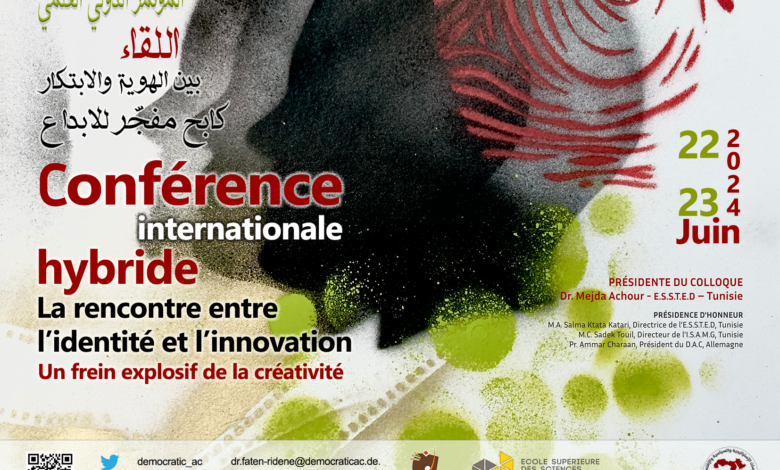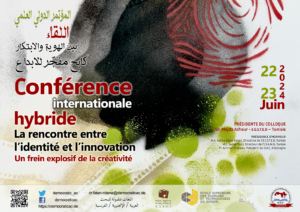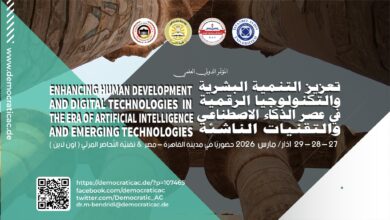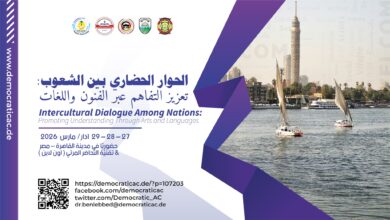The encounter between identity and innovation An explosive brake of creativity
La rencontre entre l’identité et l’innovation Un frein explosif de la créativité

The #Democratic_Arabic_Center based in Germany – Berlin, is pleased to announce the First International Conference on
The encounter between identity and innovation An explosive brake of creativity
Date: 22-23 June 2024
Organization of the Hybrid colloquium via :
Zoom and Presential at The higher school of sciences and Technologies of Design, university of Manouba, Tunisia.
NB: Participation is free of charge
In collaboration with
- The Higher School of Design Sciences and Technologies – University Manouba, Tunisia
- Higher Institute of Arts and Crafts in Gabes, University of Gabes-Tunisia
Conference Chair : Dr. Mejda Achour – University of Manouba – Tunisia
President of the Scientific Committee : Dr. Faten Ridene, University of Jendouba, Tunisia
Honored Committee
- – M.A. HDR Salma Ktata Katari, Dean of the Higher School of Design Sciences and Technologies, University of Manouba, Tunisia
- – M.C.F. Sadek Touil, Dean of the Higher Institute of Arts and Crafts in Gabes, University of Gabes, Tunisia
- Prof . Ammar Sharaan – Head of Democratic Arabic Cente
Conference management
- Conference Director: Dr. Karim AICHE
- Director of Publication : Dr. Ahmed Bohko
The Scope of the Conference
This international, multidisciplinary conference opens up a new perspective on the intersection between identity and innovation, by inviting researchers to reflect on the different issues that can arise from any project that aims to be creative
This theme focuses on two aspects. The first stems from the paradox contained in the antithetical expression “An explosive brake”, which brings to mind states of bubbling, contemplation and cogitation, held back by various constraints, but aiming to achieve a reconciliation between identity and innovation
The second part will look at the different angles that can be taken in relation to specialities rooted in creativity and which simultaneously call upon the notions of identity and innovation. In fact, it will aim to provide information on the polysemy that emerges from the different meanings of the terms Identity and Innovation, as well as on the pluridisciplinarity of identity to which the conference relates. Certainly, the merging projections of the two conceptual spheres “Identity and Innovation”, through the various angles of vision, will affect a semantic adaptation, of the two concepts, relative to the speciality
However, anchoring “Innovation” in a creative project could converge towards an ideal goal that is novative, renewing, innovative or inventing new content. The transition or evolution from one level to another could depend on the impact of dominant or dominated identity in the idea representation through various media. The balancing between the dominance and domination of the two spheres will shape the metaphorical image of the creator’s reflexive bubbling and the various correlations that result in the face of the different backwardness factors of perceptible creativity
The pluridisciplinary identity in the elaboration of a creative project could be both a brake and a stimulating source of innovation. Furthermore, identity could exist as a pioneering value, intrinsic and integral, and/or extrinsic, perceptible in the various components of the creative process. On the other hand, could this identity become a factor that can be modelled by innovation, keeping its original detectable signs as a stimulating source of innovation
Moreover, identity could exist as a pioneering value, intrinsic and integral, and/or extrinsic, perceptible in the various components of the creative process but could this identity become a factor that can be modelled by innovation, while retaining its original detectable signs
On the other hand, identity could be manifested through the mechanisms and artefacts of representation, just as it will be embodied in the same associations and articulations of these mechanisms. Let us take the example of Andy Warhol’s identity through his screen-printing of Marilyn Monroe, even though screen-printing already existed, the identity of the creator could be seen in the work through the technicality and know-how in design, art, cinema, theatre, architecture, etc., that are always bouncing off innovation
Main Objectives
- To identify the visible signs of contingent concepts resulting from the encounter between identity and innovation through creative work from various specialities in the fields of design, the arts, cinema, etc
- To present analyses and solutions to problems arising from the encounter between identity and innovation
- To discover the processes involved in modelling the identity imprint during the development and innovation of a creative project in various fields
- To facilitate and update pedagogical teaching while maintaining the identity philosophy of the higher education institution
Topics of the Conference
- Technological innovation and the shaping of identity. Technological innovation dominates and/or dissipates identity, highlighting the impact of new technologies on individual and collective identity
- Identity sacralisation: innovation or mimesis This line of research highlights the redundancies that could result from the sacralisation of identity, through each step of the creation process of a new project. In this case, excessive representation of identity could encourage imitation
- The fusion of identities: a hybrid innovation This line of research aims to examine how the integration and interaction of identities can be the source of innovation
- Social innovation and resistance: the identity crisis This theme aims to highlight the importance of identity innovation in overcoming social obstacles and resisting identity crisis
- Heritage identity: an innovative material and/or immaterial representation
of values, experience and/or emotion. This section seeks to enhance heritage identity by representing various tangible and intangible innovations, and expressing values, experiences and emotions
- Teaching methods between identity philosophy and innovation. This line of research analyzes the various pedagogical methods used in teaching, following the philosophical specificities of an academic institution’s identity, showing the different phases of innovation
Scientific Committee
- Emeritus Hammadi BOUABID, University of Carthage, Tunisia
- Khaldoun Zreik, University of Paris 8, France
- Michela Déni, University of Nîmes, France
- Houcine Ben Slimane, University of el Manar, Tunisia
- Mounira ben Mustapha Hachana, University of Tunis, Tunisia
- Sana Jemmali Ammari, University of Sousse, Tunisia
- Jaouhar Jammoussi, University of Manouba, Tunisia
- Ahmed Gamaleldin Bilal, Scientific College of Design, Oman
- Abdelaziz Amraoui, University of Cadi Ayyad, Marocco
- Fathy Elsmadissy, University of Damanhour, Egypte
- Mondher Al-Atoum, University of Yarmouk, Jordan
- Ikbel Charfi, University of Sfax, Tunisia
- Pr. Dr Hafedh Rekik, University of al Qassim, Saudi Arabia
- Pr. Dr Hamid Tbatou, University of Ibn Zohr, Marocco
- Pr. Dr Mohamed Ghazela, University of Effat, Saudi Arabia
- Pr. Dr Sadok Touil, University of Gabes, Tunisia
- Pr. Dr Mohamed Tarek Ben Chaabane, University of Carthage, Tunisia
- Pr. Dr Ouafa Ouarniki, University of Djelfa, Algeria
- Pr. Dr Mohamed Badir, University of Tlemcen, Algeria
- Pr. Dr Anis Semlali, American University of Ras Al Khaimah, United Arab Emirats
- Pr. Dr Anouar Ben Khalifa, University of Jendouba, Tunisia
- Pr. Dr Assia Marfouq, University of Hassan I, Marocco
- Pr. Dr Abdelghani Brija, University of Mohamed V, Marocco
- Pr. Dr Mohamed Marzagui, University of Cadi Ayyad, Marocco
- Pr. Dr Samira Oualhazi, University of Jendouba, Tunisia
- Pr. Dr Samiha Khelifa, University of Manouba, Tunisia
- Pr. Dr Manoubia Ben Ghedahem, University of Carthage, Tunisia
- Pr. Dr Chiraz Kilani, University of Tunis, Tunisia
- P Dr Salma Ketata, University of Manouba, Tunisia
- P Dr Rym Zayeni, University of Manouba, Tunisia
- P Dr Naoufel Abbes, University of Manouba, Tunisia
- P Dr Aicha Kamoun, University of Manouba, Tunisia
- P Dr Amira Turki, University of Jendouba, Tunisia
- P Dr Amir Hamzaoui, University of Manouba, Tunisia
- P Dr Amina Tekitek, University of Manouba, Tunisia
- P Dr Neila Zanned, University of Manouba, Tunisia
- P Dr Rim Lahmar, University of Manouba, Tunisia
- P Dr Ali Chamseddine, University of Gabès, Tunisia
- P Dr Omar Aloui, University of Jendouba, Tunisia
- P Dr Faten Ridene, Université de Jendouba, Tunisia
- P Dr Wassim Jmal, University of Sfax, Tunisia
- P Dr Maya Ben Ayed, University of Paris I Panthéon-Sorbonne, France
- P Dr Imen Samet Arous, University of Jendouba, Tunisia
- P Dr Faten Hamdi, University of Jendouba, Tunisia
- P Dr Ali Mawlood Fadhil Al Sammrraie, University of Issra, Irak
- P Dr Yassine Halouani, University of Carthage, Tunisia
- P Dr Nouheil Salloum, University of Sultan Qaboos, Oman
- P Dr Hela Chabchoub, University of Manouba, Tunisia
- P Dr Ahlem Hamed, University of Gabès, Tunisia.
- P Dr Mohamed Abdelouahab Yousfi, University of Tunis el Manar , Tunisia.
- Henda Boukeri, University of Manouba, Tunisia
- Asma Manai, University of Manouba, Tunisia
- Mejda Achour, University of Manouba, Tunisia
References
- Bazin, A. (1999). Qu’est ce que le cinéma (Vol. 3). Paris, France: Editons du Cerf. Consulté le 11 02, 2015
- Danto, A. (1989). La transfiguration du banal, une philosophie de l’art. Paris : Edition du Seuil
- Deleuze, G. (1985). L’image-temps. Paris: Les Editions de Minuit collection « Critique »
- Dubar, C. (2000). La crise des identités. Paris: Presses Universitaires de France
- Eco, U. (1965). L’œuvre ouverte. Editions du Seuil
- Gérard Genette. (1982). Palimpsestes la littérature au second degré. Editions du Seuil
- KOGAN, A.-F., & ANDONOVA, Y. (2015). Actes du colloque « De l’injonction à la créativité à sa mise en œuvre : quel parallèle entre monde de l’art et monde productif ? ». Nantes, France: miMSH Ange-Guépin
- Merleau-Ponty, M. (1964). L’Œil et l’esprit. version numérique par Nicolas Ouellette
- Muriel, G. (2001). L’identité narrative: une reprise à partir de Freud de la pensée de Paul Ricœur. Genève: Labor et fides
Terms and Conditions for Participation and Publication
- The submission should be within (15 pages) including references, tables, figures, and images
- Participating researchers must follow the recognized scientific principles for research preparation and writing, especially in terms of documenting information sources, citations, and maintaining scientific integrity regarding references, in addition to the correctness of language and style
- Submissions are accepted in English
- Individual and joint submissions are accepted, and doctoral students are allowed to participate with their supervising professors
- It is mandatory to attach a brief curriculum vitae of the participant
- The first page of the article should include the complete title of the article in the language of the research and a translation of the article’s title in English for articles written in other languages. It should also include the name of the researcher, their academic position, affiliated institution, city, country, email, and two abstracts with keywords. The number of lines in a single abstract should not exceed ten lines
- The article should be written in Times New Roman font size 12, with margins of 2 cm on all sides and line spacing of 1 cm
- The documentation style is APA, where references are cited in the text by mentioning (Author, Year, Page) within parentheses, and full reference details are provided at the end of the research
- Research papers are subject to scientific review, and the participating researcher is committed to adjust to the research in light of the reviewers’ comments if requested. This is in preparation for publication, and the conference committee has the right to make some formal modifications to the article when necessary without affecting the content
Submissions that meet the above conditions should be sent to the email
dr.faten-ridene@democraticac.de
Participation Rights
- – Participation is free of charge
- – The participating researcher will receive an electronic copy of the conference proceedings, in addition to a certificate confirming their participation
- – Research studies only represent the views of their authors, and they alone bear full responsibility for data validity and any subsequent issues related to scientific ethics and integrity
Important Dates
- Deadline for abstract submission: 01/03/2024
- Notification of results to applicants starting :18/03/2024
- Deadline for submission of the final paper : 08/05/2024
Democratic Arab Center For Strategic, Political & Economic Studies
Deutschland – Berlin
Continue on the Viper-Whats App : 00491742783717



